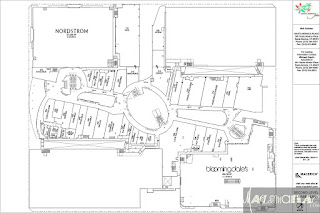A dead mall
When I do my trips, I do plenty of vetting beforehand, especially with Google Maps. That’s how I’m able to find some of the little known treasures on this site, such as New Landing Mall in Kansas city. I hate to admit this, but Captain D’s is one of my favorite gross, disgusting comfort food places and since they don’t have any in the Pacific Northwest, when I travel I like to check for locations at my destination. There was one in KC, but I also noticed this drab building across the street from it that looked a bit mall-like. It turned out to be just like the old, sixties fabulous shopping center that I love discovering. This was not how I found the Los Angeles Mall. I came upon this place by pure luck alone, but I’m so glad that luck was on my side that day.
Although times are changing, there was a well-worn phrase back in the day that nobody goes to downtown LA. Me, I don’t care what city I’m in, the CBD is always a must-go-to destination. I had arrived earlier in the day at Ontario International Airport which, at least back in 2018, looked like the airport version of a dead mall. I took the long but "scenic" Metrolink train from the Fontana station to Union Station just to the northeast of the main downtown core to begin my trip.
Walking to the southwest on Los Angeles Street just past Highway 101, I faced the iconic Los Angeles City Hall building. But in its shadow was something I had no idea existed, and had I not been the retail hound that I am, I would have missed it. The signs labeled it Los Angeles Mall. It was an empty, sunken plaza in the middle of a bright and busy downtown. I couldn’t wait to walk down the steps to explore.
What I found was a treasure trove of mid-twentieth century modern and brutalist architecture harmoniously coexisting in what looks to be an unchanged state since its opening. It was like I had taken a time machine back to the seventies. Underneath me was dark tile and brick. All around me were the sparse ornamentations, clean lines, and ample foliage that are some of the trademarks of the two movements. I loved it all, but as this was a surprise find, I did not know the significance of the Triforium sculpture and Howard Troller bridge, so I only caught passing glances of each.
Los Angeles Mall opened in 1974 and was intended to be a new “town square” for the young but bustling city. It has never contained any traditional anchors but was more designed as a place where people could gather for both business or recreation. It was filled with various art installations, including the aforementioned Triforium sculpture. The two main plazas are the South Mall Plaza, which lies next to the brutalist City Hall East and the North Mall Plaza, which contains the Triforium sculpture as well as a sunken area abutting the former children’s museum and featuring the center’s food court.
Unfortunately, the mall has never seen much success. The children’s museum was moved around the turn of the millennium and the complex, while relatively clean, doesn’t see much traffic outside of the area’s homeless population. There are plans to demolish the facility, though no concrete plans have been put into action. Having never fulfilled its promises, the land that Los Angeles Mall sits upon presents the area with new possibilities for revitalization. I hope the city takes advantage of it.




























































